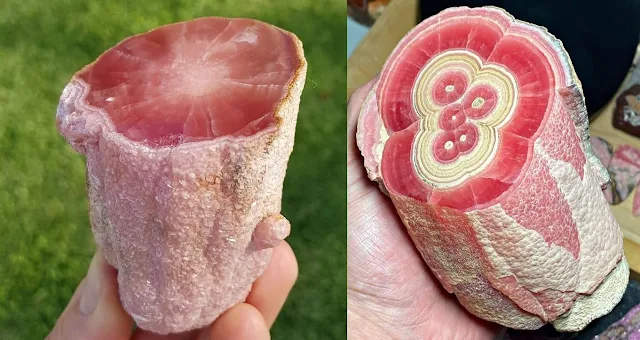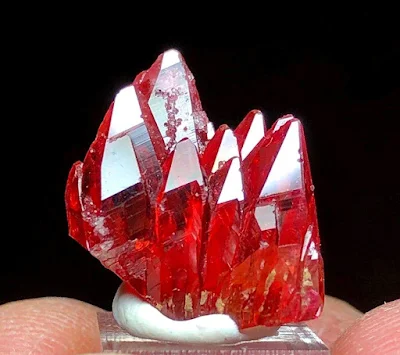Rhodochrosite: Manganese Carbonate Mineral
Rhodochrosite is a manganese carbonate mineral with chemical composition MnCO3. In its (rare) pure form, it is typically a rose-red color, but impure specimens can be shades of pink to pale brown.
It was first described in 1813 in reference to a sample from Cavnic, Maramureş, present-day Romania. According to Dimitrescu and Radulescu, 1966 and to Papp, 1997, this mineral was described for the first time in Sacaramb, Romania, not in Cavnic, Romania. The name is derived from the Greek word ῥοδόχρως meaning rose-colored.
It streaks white, and its Mohs hardness varies between 3.5 and 4. Its specific gravity is between 3.5 and 3.7. It crystallizes in the trigonal system, and cleaves with rhombohedral carbonate cleavage in three directions.
Rhodochrosite occurs as a hydrothermal vein mineral along with other manganese minerals in low temperature ore deposits as in the silver mines of Romania where it was first found. Banded rhodochrosite is mined in Capillitas, Argentina.
Rhodochrosite forms a complete solid solution series with iron carbonate (siderite). Calcium, (as well as magnesium and zinc, to a limited extent) frequently substitutes for manganese in the structure, leading to lighter shades of red and pink, depending on the degree of substitution. It is for this reason that the most common color encountered is pink.
 |
Rhodochrosite stalactite from Capillitas Mine, Andalgalá, Catamarca, Argentina Credit: Argentina Minerals |
Its main use is as an ore of manganese which is a key component of low-cost stainless steel formulations and certain aluminium alloys.
The formation of rhodochrosite usually occurs in fractures and cavities of metamorphic and sedimentary rocks. It is often associated with silver deposits, and a few silver mines produce rhodochrosite as a byproduct. Some of the common modes of occurrence and their lapidary uses are described below.
In massive form, Rhodochrosite’s pink and white bands are extremely attractive and often used in semi-precious jewelry, decorative stones or carved into figurines, while stalactitic forms are cross-cut in slices to display their unique concentric bands. Fine transparent crystals are rare and costly, sometimes faceted into gems for collectors, however the softness and brittleness limit it as a gemstone for everyday usage.
Rhodochrosite is a secondary source for manganese metal, used for aluminum alloys, brilliant transparent verities as a decorative stone, and jewelry.
Rhodochrosite occurs in bedded, marine, sedimentary deposits along with various Mn oxides. These deposits are thought to mostly represent chemical sediments, although sometimes there does seem to be an association with volcanic rocks, suggesting that precipitation from hot springs could be important, rather akin to the proposed environment of Algoma type banded iron formations.
Massive material from Argentina occurs in large pieces. Gem cutters have cabbed and carved this material into decorative as well as useful objects, such as boxes. Aggregate rhodochrosites can show white or grey jagged bands. Facetable, translucent pink material cuts stones up to about 20 carats.
 |
| The trapiche-like rhodochrosite “flower” from Argentina’s Capillitas mine. Credit: Russell E. Behnke |
The Capillitas mine in Argentina’s Catamarca Province has also produced very rare trapiche-like rhodochrosites. Some sections of stalactitic rhodochrosites have revealed stunning, star-like “floral” patterns.
 |
| Lustrous Rhodochrosite Scalenohedrons from the N'chwaning Mine, Kalahari Mn Fields, Northern Cape Province, South Africa. Credit: Anatoly Bitny |
South African rhodochrosites have a rich, rose red color but rarely occur in facetable crystals. The largest cut gems are in the 60-carat range.
 |
| Rhodochrosite avec Quartz, Fluorite et sulfures "Centennial pocket" of the Sweet Home mine in Alma, Colorado, USA. Collection & photo: Simone Citon |
Colorado produces pink gems, perhaps the loveliest of all. Faceters have cut flawless gems up to about 15 carats. However, most stones range under five carats in size.
See also:
Chalcanthite: Facts About Chalcanthite
Tourmaline: Species and Color Varieties
Why Fluorite Comes in Different Colors?

%20(1).webp)






